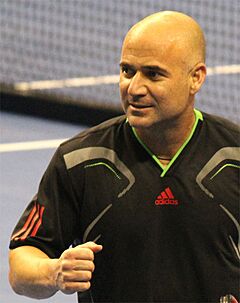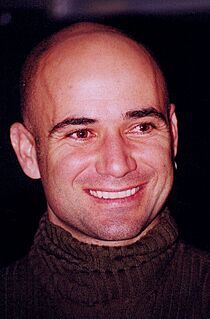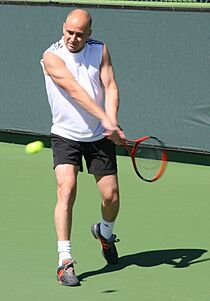Andre Agassi facts for kids

Agassi at the 2011 Champions Shootout
|
|||||||||||
| Full name | Andre Kirk Agassi | ||||||||||
|---|---|---|---|---|---|---|---|---|---|---|---|
| Country (sports) | |||||||||||
| Residence | Las Vegas, Nevada, US | ||||||||||
| Born | April 29, 1970 Las Vegas, Nevada, US |
||||||||||
| Height | 5 ft 11 in (1.80 m) | ||||||||||
| Turned pro | 1986 | ||||||||||
| Retired | 2006 | ||||||||||
| Plays | Right-handed (two-handed backhand) | ||||||||||
| Coach |
|
||||||||||
| Prize money | $31,152,975
|
||||||||||
| Int. Tennis HoF | 2011 (member page) | ||||||||||
| Singles | |||||||||||
| Career record | 870–274 (76.05%) (76.0%) | ||||||||||
| Career titles | 60 | ||||||||||
| Highest ranking | No. 1 (April 10, 1995) | ||||||||||
| Grand Slam singles results | |||||||||||
| Australian Open | W (1995, 2000, 2001, 2003) | ||||||||||
| French Open | W (1999) | ||||||||||
| Wimbledon | W (1992) | ||||||||||
| US Open | W (1994, 1999) | ||||||||||
| Other tournaments | |||||||||||
| Tour Finals | W (1990) | ||||||||||
| Grand Slam Cup | F (1998) | ||||||||||
| Olympic Games | W (1996) | ||||||||||
| Doubles | |||||||||||
| Career record | 40–42 (48.8%) | ||||||||||
| Career titles | 1 | ||||||||||
| Highest ranking | No. 123 (August 17, 1992) | ||||||||||
| Grand Slam doubles results | |||||||||||
| French Open | QF (1992) | ||||||||||
| US Open | 1R (1987) | ||||||||||
| Team competitions | |||||||||||
| Davis Cup | W (1990, 1992, 1995) | ||||||||||
| Coaching career (2017–2020) | |||||||||||
|
|||||||||||
| Signature | |||||||||||
 |
|||||||||||
|
Medal record
|
|||||||||||
Andre Kirk Agassi (born April 29, 1970) is an American former professional tennis player. He was ranked as the world No. 1 in men's singles for 101 weeks. This included being the year-end No. 1 in 1999.
Agassi won 60 major singles titles, including eight Grand Slam tournaments. He achieved the Career Grand Slam, meaning he won all four major tournaments. He also won an Olympic gold medal in 1996. Agassi was part of the winning United States Davis Cup teams in 1990, 1992, and 1995. He is one of only three men to complete the career Golden Slam in singles. This means winning all four Grand Slams and an Olympic gold medal.
Agassi became a star at a young age. He won his first major title at Wimbledon in 1992. He then won the 1994 US Open and 1995 Australian Open. This helped him reach the world No. 1 ranking for the first time. After facing some challenges, Agassi worked hard to improve. He returned to the world No. 1 spot in 1999. He completed the Career Golden Slam at the French Open that year. He also won another US Open title and three more Australian Open titles. Agassi retired from tennis after the 2006 US Open.
Many people consider Agassi one of the greatest tennis players ever. He was the first man to win all four singles majors on three different surfaces: hard, clay, and grass. He is also known for his powerful "return of serve." Outside of tennis, Agassi started the Andre Agassi Charitable Foundation. This foundation has raised over $60 million to help children in Southern Nevada. In 2001, the foundation opened the Andre Agassi College Preparatory Academy. This is a public charter school for children in Las Vegas. He has been married to fellow tennis legend Steffi Graf since 2001.
Contents
Early Life and Training
Andre Agassi was born in Las Vegas, Nevada, on April 29, 1970. His father, Emmanuel "Mike" Agassi, was a former Olympic boxer. His mother is Elizabeth "Betty" Agassi. Andre has three older siblings.
When he was 12, Agassi and his friend Roddy Parks won a national doubles championship. At 13, Agassi went to Nick Bollettieri's Tennis Academy in Florida. His father could only afford three months. But after watching Agassi play, Bollettieri was so impressed that he offered him a free spot. Agassi then left school to focus on his tennis career.
Professional Tennis Career
Starting Strong: 1986–1993
Agassi became a professional tennis player at age 16. He won his first top-level singles title in 1987. By the end of 1988, he was ranked No. 3 in the world. He had also earned over $1 million in prize money faster than anyone before him.
Agassi did not play at the Australian Open for his first eight years. He also skipped Wimbledon from 1988 to 1990. He didn't like Wimbledon's strict traditions, especially the all-white dress code.
He reached his first Grand Slam final at the 1990 French Open. He lost to Andrés Gómez. Later that year, he reached the US Open final, losing to Pete Sampras. This started a big rivalry between them. Agassi ended 1990 by helping the United States win its first Davis Cup in eight years. He also won his only Tennis Masters Cup.
In 1991, Agassi reached another French Open final, losing to Jim Courier. His big Grand Slam win came at Wimbledon in 1992. He beat Goran Ivanišević in a tough five-set final. Agassi also helped the U.S. win the Davis Cup again in 1992.
In 1993, Agassi won his only doubles title. He missed part of the year due to injuries. He lost to Pete Sampras in the Wimbledon quarterfinals.
Reaching the Top: 1994–1997
With his new coach, Brad Gilbert, Agassi changed his playing style. He became more tactical and consistent. In 1994, he won the Canadian Open. He then became the first unseeded player to win the US Open. He beat five seeded players on his way to the title.
In 1995, Agassi won the 1995 Australian Open, beating Sampras in the final. Agassi and Sampras met in five finals that year. Agassi won three of them. Agassi also won three Masters Series events and seven titles in total. He had a 26-match winning streak that summer. He reached the world No. 1 ranking for the first time in April 1995. He held this spot for 30 weeks. Agassi also helped the U.S. win the Davis Cup for the third time.
Agassi had a tougher year in 1996. He didn't reach any Grand Slam finals. But he won the men's singles gold medal at the Olympic Games in Atlanta. He also defended his titles in Cincinnati and Key Biscayne.
In 1997, Agassi faced many challenges. He played only 24 matches due to a wrist injury. He also struggled with his personal life and lost interest in tennis. His ranking dropped to No. 141. Many thought his career was over.
Return to Glory: 1998–2003
In 1998, Agassi started a tough training program. He played in smaller tournaments to improve his ranking. He worked hard to get back into top shape. He won five titles in 1998 and jumped from No. 110 to No. 6 in the rankings. He was named the ATP Most Improved Player of the Year for the second time.
In 1999, Agassi made history. He came back from two sets down to win the French Open final. This made him one of only five male players to win all four Grand Slam singles titles in their career. This win also made him the first male player to win all four Grand Slam titles on three different surfaces (clay, grass, and hard courts). He also became the first male player to win the Career Super Slam. This includes all four Grand Slams, an Olympic gold medal, and a Year-end championship.
After the French Open, Agassi reached the Wimbledon final but lost to Sampras. He then won the US Open, beating Todd Martin in a five-set final. Agassi ended 1999 as the world No. 1.
In 2000, Agassi won his second Australian Open title. He beat Sampras in a five-set semifinal. He reached the semifinals at Wimbledon, losing to Pat Rafter in a memorable five-set match.
Agassi successfully defended his Australian Open title in 2001. He beat Arnaud Clément in the final. At the US Open, he lost a long, close match to Sampras in the quarterfinals. Agassi finished 2001 ranked No. 3. He was the only male player to finish a year in the top 3 in three different decades.
In 2002, Agassi missed the Australian Open due to injury. He later won the Key Biscayne title, beating a young Roger Federer in the final. At the US Open, Agassi reached the final. He played Sampras in their last career match, which Sampras won. Agassi finished 2002 as the oldest year-end No. 2 player at 32 years old.
In 2003, Agassi won his eighth and final Grand Slam title at the Australian Open. He beat Rainer Schüttler in the final. On April 28, 2003, he became the oldest top-ranked male player at 33 years old. He held the No. 1 ranking for a total of 101 weeks in his career. Agassi finished 2003 ranked No. 4.
Final Years: 2004–2006
In 2004, Agassi lost in the Australian Open semifinals to Marat Safin. This ended his 26-match winning streak at the event. He won the Masters series event in Cincinnati. This brought his total to 59 singles titles and a record 17 ATP Masters Series titles. He finished 2004 ranked No. 8.
Agassi's 2005 season included a great run to the US Open final. He won three straight five-set matches to reach the final. This included a comeback win against James Blake. In the final, he lost to Roger Federer. Agassi finished 2005 ranked No. 7. This was his 16th time in the year-end top 10, tying Jimmy Connors' record.
Agassi had a difficult start to 2006 due to injuries. He missed the Australian Open and the entire clay-court season. He returned for Wimbledon, where he lost in the third round to Rafael Nadal. At Wimbledon, Agassi announced he would retire after the US Open.
In his final US Open, Agassi had a dramatic run. He played through extreme back pain. He won two tough five-set matches. In his last match, he lost to Benjamin Becker. Agassi received a long standing ovation from the crowd and gave a moving retirement speech.
Major Rivalries
Agassi vs. Sampras
The rivalry between Andre Agassi and Pete Sampras was one of the biggest in tennis. Sampras was known for his powerful serve, and Agassi for his amazing serve return. Sampras won 20 of their 34 matches.
Their first Grand Slam final was at the 1990 US Open, which Sampras won. They met in many other important matches, including the finals of the 1995 Australian Open and US Open. Sampras won the 1995 US Open final.
They faced each other in the 1999 Wimbledon final, which Sampras won. Their last Grand Slam meeting was the 2002 US Open final. Sampras won this match, which was the last of his career.
Agassi vs. Chang
Agassi played Michael Chang 22 times, with Agassi winning 15 matches. Both players liked to stay at the back of the court. Their matches often featured long and exciting rallies. Agassi won their first four matches. One of their best matches was at the 1994 US Open. Agassi won in five sets on his way to his first US Open title.
Agassi vs. Becker
Agassi and Boris Becker played 14 times, with Agassi winning 10 matches. Becker won their first three matches. Agassi then figured out Becker's serve and won most of their later matches. A notable match was the 1992 Wimbledon quarterfinal. Agassi, who was not known for playing well on grass, surprised Becker, a three-time champion, in a five-set match.
Agassi vs. Rafter
Agassi and Pat Rafter played 15 times, with Agassi winning 10 matches. Their matches were exciting because of their different styles. Rafter used a serve-and-volley style, while Agassi focused on returning serves and hitting passing shots. They played four times at Wimbledon, with each winning two matches. Their matches in 2000 and 2001 were long five-setters.
Life After Retirement
Since retiring, Agassi has played in many charity tennis events. He continues his work with his foundation. In 2009, he presented Roger Federer with the French Open trophy.
Agassi has also played in exhibition matches against other tennis legends. In 2009, he played Pete Sampras in Macau. In 2010, they played in a charity event called "Hit for Haiti." Agassi and Sampras met again in exhibition matches in New York and London.
In 2017, Agassi became a coach for Novak Djokovic. They worked together for about a year before ending their partnership.
Legacy in Tennis
Many people believe Agassi is one of the greatest tennis players of all time. He is known as one of the best serve returners ever. He is also credited with helping to make tennis more popular in the 1990s.
Agassi received many awards for his career. He was named the BBC Overseas Sports Personality of the Year in 1992. In 2011, he was inducted into the International Tennis Hall of Fame.
Agassi earned over $30 million in prize money during his career. He also earned a lot from endorsements, which are deals with companies to promote their products.
Playing Style
Early in his career, Agassi liked to finish points quickly. He would hit deep, hard shots to make his opponent hit a weak return. Then he would hit a winning shot. His best shot was his flat, accurate two-handed backhand. His forehand was also very strong.
Later in his career, with coach Brad Gilbert, Agassi became more tactical. He would hit deep shots to wear out his opponents. He was very good at taking the ball early, right after it bounced. This allowed him to control the point. A special shot he used later was a drop shot, which would often be followed by a passing shot.
Agassi grew up playing on hardcourts. But he had early success on clay courts, reaching two French Open finals. Even though he said he didn't like grass courts, his first major win was at Wimbledon on grass. His strongest surface throughout his career was hardcourt, where he won six of his eight major titles.
Business and Charity Work
Agassi has been involved in many business ventures. He opened a chain of sports-themed restaurants called Official All Star Café, which later closed. He also invested in a bank and partnered with a chef to open restaurants.
Agassi and his wife, Steffi Graf, formed a company called Agassi Graf Holdings. They invested in a nightclub and launched a furniture line. They also invested in a water park in Las Vegas, Wet'n'Wild Las Vegas, which opened in 2013.
Agassi has had endorsement deals with many companies, including Head rackets, Adidas, Nike, and Longines watches.
Helping Others: Philanthropy
Agassi founded the Andre Agassi Charitable Association in 1994. This organization helps young people in Las Vegas. He received an award in 1995 for his efforts to help disadvantaged youth. He is known as one of the most charitable athletes of his time.
His charities help children reach their potential. His Boys & Girls Club helps 2,000 children each year. It has a tennis team and a basketball program. In 2001, Agassi opened the Andre Agassi College Preparatory Academy in Las Vegas. This is a free charter school for children who need extra support. He personally donated $35 million to the school. The school has a very high graduation rate.
Agassi also supports Child Haven, a home for abused and neglected children. He helped build a classroom building and a facility for children with special medical needs. In 2007, Agassi helped start Athletes for Hope. This charity helps professional athletes get involved in good causes.
Personal Life
Andre Agassi married actress Brooke Shields in 1997, but they divorced in 1999.
He married fellow tennis star Steffi Graf on October 22, 2001. They have two children: a son named Jaden Gil (born 2001) and a daughter named Jaz Elle (born 2003). Agassi and Graf have said they don't push their children to play tennis. Their son Jaden plays baseball. The Agassi-Graf family lives in Las Vegas, Nevada.
His Autobiography
Agassi's autobiography, Open: An Autobiography, was published in 2009. In the book, Agassi talks about his childhood and his demanding father. He also shared that he often felt pressure and didn't always enjoy tennis during his career. The book became a bestseller and received good reviews.
Career Statistics
Grand Slam Finals (8 Wins, 7 Losses)
Agassi completed a men's singles Career Grand Slam by winning the 1999 French Open. He is one of only eight male players in history to achieve this.
| Result | Year | Championship | Surface | Opponent | Score |
|---|---|---|---|---|---|
| Loss | 1990 | French Open | Clay | 3–6, 6–2, 4–6, 4–6 | |
| Loss | 1990 | US Open | Hard | 4–6, 3–6, 2–6 | |
| Loss | 1991 | French Open | Clay | 6–3, 4–6, 6–2, 1–6, 4–6 | |
| Win | 1992 | Wimbledon | Grass | 6–7(8–10), 6–4, 6–4, 1–6, 6–4 | |
| Win | 1994 | US Open | Hard | 6–1, 7–6(7–5), 7–5 | |
| Win | 1995 | Australian Open | Hard | 4–6, 6–1, 7–6(8–6), 6–4 | |
| Loss | 1995 | US Open | Hard | 4–6, 3–6, 6–4, 5–7 | |
| Win | 1999 | French Open | Clay | 1–6, 2–6, 6–4, 6–3, 6–4 | |
| Loss | 1999 | Wimbledon | Grass | 3–6, 4–6, 5–7 | |
| Win | 1999 | US Open | Hard | 6–4, 6–7(5–7), 6–7(2–7), 6–3, 6–2 | |
| Win | 2000 | Australian Open | Hard | 3–6, 6–3, 6–2, 6–4 | |
| Win | 2001 | Australian Open | Hard | 6–4, 6–2, 6–2 | |
| Loss | 2002 | US Open | Hard | 3–6, 4–6, 7–5, 4–6 | |
| Win | 2003 | Australian Open | Hard | 6–2, 6–2, 6–1 | |
| Loss | 2005 | US Open | Hard | 3–6, 6–2, 6–7(1–7), 1–6 |
Professional Awards
- ITF World Champion: 1999
- ATP Player of the Year: 1999
- ATP Most Improved Player: 1988, 1998
Video Games
Andre Agassi has been featured in several video games:
- Andre Agassi Tennis
- Agassi Tennis Generation
- Smash Court Pro Tournament
- Top Spin 4
- Tennis World Tour
- Top Spin 2K25
Images for kids
See also
 In Spanish: Andre Agassi para niños
In Spanish: Andre Agassi para niños






